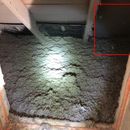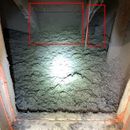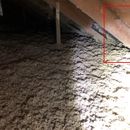Blown-In Cellulose in Contact with Roof Sheathing
Hello,
I have been a reader since I started a large home improvement project early this year and am grateful for the knowledge on this platform.
I can give more context and background details about the entire project if needed but I will try to keep it brief for now. I have read similar questions but I had not read definitive answers that I could apply directly to my situation, so wanted to post my own. FYI, located in Ohio, Zone 5 climate.
Two days ago, I just insulated a vented attic with blown-in cellulose (DIY) to a target of R-60 or around 17.5″. Soffit vents exist for 85% of the soffits/eaves. There are probably 7 “rafter bays” that are not vented and just end at the eave above the top plate exterior walls (due to valleys in the roof and also a dormer added on top of the existing roof). Before blowing in, I added baffles and sealed them with spray foam but did not add baffles to these 7 bays thinking that it was not needed because of the lack of soffit vents.
This morning I woke up and got really worried that I screwed up and should have added baffles to allow for an air gap even on these non-vented bays. My worry is mold, rotted sheathing, frost, etc. forming between the sheathing and cellulose that are in contact in these 7 bays. I attached a few photos of examples (not showing all the bays, as some are not as easily accessible from the access doors I made).
Before I go back into the attic to do anything, potentially screwing up the R-value of the blown-in I just did, can anyone give some advice? Is it worth it to go back in and do something? What should I do if anything?
My thoughts on options:
1. Do nothing – I’m overreacting.
2. Try to install baffles after the fact, pulling back the insulation with cardboard and inserting the baffle over top of the cellulose. Then gently push the cellulose back in place.
3. Do the same as #2 but instead of a baffle, use a piece of 2″ poly-iso that I have laying around after insulating the backs of knee walls and doing the cut and cobble in the cathedral ceiling in the 2nd-floor dwelling space. Idea here is that the 1-2″ gap the baffle does will do little without a soffit vent, so just insulate it with R-13 poly-iso.
I don’t see how it will be possible with the attic already insulated to make either #2 and #3 perfect, having no cellulose touching the sheathing. In either, I imagine that some cellulose will still be touching the sheathing.
Help is greatly appreciated!
GBA Detail Library
A collection of one thousand construction details organized by climate and house part












Replies
greenDIYer,
I don't think it's a problem. The situation is quite close to what you routinely see in walls with no adverse effects. Cellulose is very good at redistributing any moisture it takes up, and as it isn't enclosed it can dry into the attic.
Both #2 and #3 would work, but if it were me I'd leave well enough alone.
Thanks for the reassurance. What you said sounds logical to me, however, what's strange is that I have seen a few comments on here about keeping insulation away from the roof sheathing. Is this because the roof acts differently than an exterior wall when it comes to heat, cold, moisture, temp. changes, etc.? If I remember correctly it seemed that the comments were not related to venting soffit vents either - which is the obvious reason for this.
FWIW, after inspecting again and looking at photos before I blew it in, it looks like there are only 4-5 bays.
greenDIYer,
There are definitely important differences between walls and unvented roofs - and I'd never suggest cellulose against a roof surface is a safe assembly - except where is it localized, and has good proximate places to dry to - as in your case.
The detail you have inadvertently ended up with is the standard one used by insulators here in the PNW on trussed roofs. They keep enough bays clear to meet the code required ventilation, and block the rest with fg batts, and fill the attic with cellulose - which at the blocked bays ends up against the roof sheathing. It's not a great detail for a number of reasons, but it performs fine, with no damage to the roof sheathing.
I appreciate the reply. Thanks for confirming that drying out to the rest of the vented attic space is sufficient. So in your opinion, I don't need to do anything?
Can I ask why it's not a great detail for a number of reasons if it performs fine with no damage?
greenDIYer,
The downsides are due to the way it is done here, not inherent to the idea itself.
- Using batts to block the cellulose from getting into the soffits means it is subject to wind-washing right over the exterior wall top plates.
- Opening up just enough bays to meet code mandated ventilation often means leaving areas with little circulation.
So it works fine, but isn't the type of detail that typically appeals to GBAers.
The cellulose will settle after a time.
I would consider having baffles in ALL bays a plus, but I doubt you'll have a problem here. It's common to have the odd corner or bump-out in an attic that isn't really "vented", but you still end up with enough air circulation in the attic space itself that there is rarely a problem. I would try to be doubly sure of the attic floor air sealing in these areas, but aside from that, I really don't think you'll have a problem here.
Note that the cellulose will settle a bit over time, so it is unlikely to stay right against the sheathing for too long regardless.
Bill
Yes, these areas are exactly what you said, bump-outs or areas that are not vented directly to a sofit vent.
I was very careful in air sealing the floor and prior to installing the baffles and well before the cellulose was installed this past weekend. I also sealed the bottom of the vents to the top plates with foam since I could not staple enough with the pitch of my roof. Also did my best to seal the exterior wall top plates as well where I could with my extended foam gun. Not perfect but way better than what it was before (no air sealing), that's for sure.
Thanks for your thoughts and for helping relieve my worry!
I agree with the others that the cellulose will settle a bit over time, but I want to be clear about why, since many people think that cellulose always settles. It doesn't, if installed at the proper density: at LEAST 3.5 pcf and preferably closer to 4.0 pcf. Installers are supposed to do at least 3.5 pcf but to avoid blowing out the netting or drywall, almost every installation I've seen is at a lower density. It should feel like a VERY firm mattress, not like a fluffy pillow. Loose-blown is 1.8 pcf so when it's installed at twice its loose density, there just isn't space for it to settle. If you remove the netting, cellulose at the proper density should stay in place.
Even installed at proper density, in an unvented roof you'll get moisture accumulation at the sheathing and result in the cellulose pulling away from the sheathing.
When you mention 3.5 - 4.0 pcf, are you talking about dense packing a stud bay or rafter bay?
If you look at the photos, I did not dense pack any sort of wall or cathedral ceiling cavity. I am talking loose blown-in cellulose in a vented attic space. The spaces I am worried about are the eaves where there are no soffit vents, and where I did not install baffles due to no soffit venting. This allowed the cellulose to touch the roof sheathing from the max height of ~17.5" all the way down to the exterior wall top plate or so.
Also, my roof is vented (only exception would be the specific 4-5 "rafter bays" that I mentioned above that do not have soffit venting). From what I read, I still consider the roof assembly to be vented.
Yes, the 3.5-4.o pcf is for dense-packed cellulose, which is not applicable to your blown insulation in a vented attic.
I think Maines is on a tangent, pointing out that PROPERLY dense-packed cellulose won't noticeably settle. I think this is a sore point with a lot of people, as there are a lot of companies and DIYers that don't sufficiently pack the cellulose, and subsequently give it a bad name when it does settle. Again, this is not applicable in your situation.
Ah, I missed the photos and yes, I was assuming dense-packed cellulose. With loose-blown I wouldn't worry a bit.
Update:
Thanks for all the advice to everyone that replied to my post. I have decided to leave things as they are due to settling overtime and the fact that the rest of the rafter bays and soffits are all vented already.
In the bays that I can see from the access doors, it looks like there is now about a 1" gap between the cellulose and the sheathing due to the cellulose settling. Of course, I'm sure some is still touching closer to the bottom, but overall I think things will be okay since everything else is vented.
Thanks again. :)
I'm working through a similar concern now and this answered my question. You didn't blow insulation into the actual soffit cavity in those non-baffled areas, did you? I assume you went up to where the rafters intersect the top plate but can't tell for certain from the pictures.